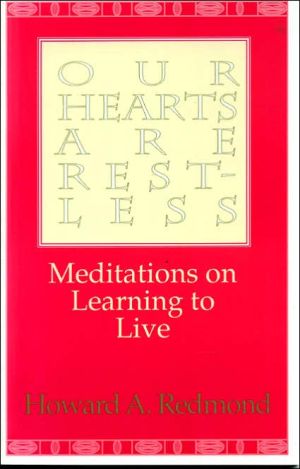

 |

|

The average rating for Our Hearts Are Restless: Meditations on Learning to Live based on 2 reviews is 4.5 stars.
Review # 1 was written on 2012-09-02 00:00:00 Kellie Hamilton Kellie HamiltonNeurophilosophy at Work is a collection of journal articles and lectures, each of which is useful for its highly specialized purpose, but which has excessive academic jargon and logical subtlety for the general reader. An example would be a lecture criticizing a Kansas school board for removing evolution and big bang theory from their required curriculum. The arguments are too erudite and convoluted to convince a beleaguered board of education, which would need a short, punchy argument, notwithstanding the noble purpose. The last Churchland book I read, The Engine of Reason the Seat of the Soul, was far more accessible, written as a popularizing textbook. Churchland likes to set up an opposition, a battle between paradigms of cognitive activity, between his model of neural networks, with massive and recurrent parallel distributed processing (PDP) and what he regards as the prevalent, conventional model of propositional attitudes, with reasoning based on language. Among the differences he points out between the models are the following: Humans and animals share many cognitive abilities, but they do not share language, so that the PDP model has a greater explanatory power. Cognitive abilities are exhibited in many physical activities such as sports and manual labor, which are too rapid to be explained by reasoned language. One would have to ask how many propositional attitudes can be formulated in a second, to account for such activity. Churchland goes back to Gilbert Ryle's distinction between "knowing how and knowing that" as anticipating the rival models, and he ultimately regards propositional attitudes or reasoned language as a "conceptual scaffolding" developed late in the cognitive game, largely for social purposes. I don't see nearly the contrast between the two models that Churchland does. They could be regarded, it seems to me, as something like vertical and horizontal cross-sections of the same phenomenon. I will elaborate on Churchland's model to explain. Within PDP processing, perceptual features can be defined using vector processing, where a vector is located in n-dimensional space (called "activational space"). For example, a taste (of lemon) might be defined in the 3-dimensional space of sweet, sour and salty, or a color (of magenta) might be defined in the 3-dimensional space of red-green, yellow-blue and black-white. With enough dimensions, such vectors can be the ending points of perceptual activities, and both the starting and ending points of further cognitive activities. Churchland acknowledges that an activational space is like a concept, and a vector within that space is an instance of that concept. The movement from one vector to another, through PDP, results in something like a judgment or inference. For example, visual input which goes through PDP may yield a vector that indicates a recognized face. This vector may go through further PDP to yield another vector which indicates an expression of surprise. Such processing amounts to a judgment. You can call it a neural network, or you can call it a propositional attitude, but it still amounts to recognizing that your friend is surprised. Churchland also offers a neural network account of semantic reference. I am highly skeptical, but his argument is far too complicated to summarize or to critique here. There is a lot left for us to study, and a lot left for Churchland (and like-minded philosophers) to explore and develop. |
Review # 2 was written on 2009-12-13 00:00:00 Nick Dipasquale Nick DipasqualeDifferent essays, some of which were extremely complex for me to understand. Some others were easier and usual involved more philosophy than algorithms. This book is also almost 10 years old, so if you need the state of the art of Neurophilosophy, it may be better to look for some other book. Differenti saggi, alcuni dei quali troppo complessi per me. Altri invece erano di piú facile comprensione e di solito avevano a che fare piú con la filosofia che con gli algoritmi. Inoltre questo libro ha quasi 10 anni quindi magari se vi serve una situazione dello stato dell'arte, magari é meglio cercare qualcosa di piú aggiornato. |
CAN'T FIND WHAT YOU'RE LOOKING FOR? CLICK HERE!!!